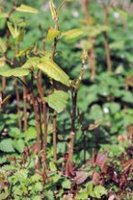 In the 1960s a hugely successful science fiction book “The Day of The Triffids” got us all worried about the country being taken over by a plague of fast growing plants. If you are in the business of redeveloping empty property you may be forgiven for thinking that reality has caught up with fiction. Japanese knotweed has been in the UK for over a hundred yeas but it’s spread particularly around abandoned land and property has grown to problematic proportions in recent years
In the 1960s a hugely successful science fiction book “The Day of The Triffids” got us all worried about the country being taken over by a plague of fast growing plants. If you are in the business of redeveloping empty property you may be forgiven for thinking that reality has caught up with fiction. Japanese knotweed has been in the UK for over a hundred yeas but it’s spread particularly around abandoned land and property has grown to problematic proportions in recent yearsJapanese knotweed is a quite extraordinary plant, It is one of the most invasive plants you will come across and the hardest to get rid of. It grows through tarmac, concrete and has even been known to grow through the floorboards of houses. It grows to a height of up to 4 meters, with bamboo like stems, arching branches and clusters of white flowers appearing in the late summer. The dead woody stems stay throughout the winter and new shoots appear each spring, they grow at an incredible rate producing impenetrable thickets within a few weeks. The dead stems and leaf litter decompose very slowly and form a thick layer that prevent other plants from growing. Once present, Japanese knotweed increases in area very rapidly and takes over completely.
One of the things that makes it so weird is that all the plants in the UK are in reality the same plant. In Japan there are male and female plants that reproduce to form seeds that germinate to form new plants. But in Europe and North America we get only female plants. All are genetically identical clones of one original female plant that got imported into Europe in the nineteenth century. Over the years bits of plant have got broken off and grown into new plants in new locations. If you consider all the plants collectively to be one organism, it has a claim to be the largest single living thing on earth!
Japanese knotweed regenerates vegetatively. This means tiny fragments of the root or the stem can grow and form new plants. So you need to be incredibly careful when you are handling it. Causing it to spread into the wild is a criminal offence in the UK under the 1981 Wildlife and Countryside Act. And carelessly disposing of it or chopping it down with a strimmer would probably be considered offences. The plants are considered to be pollutants and you can’t just sling them in the skip. You will need special permission to dispose of them. If you have it in the garden you need to take special precautions when you have building work carried out. The requirements are set out in the Environment Agency’s website.
You can get special permission to use some horrendous herbicides on Japanese knotweed, but recent research indicates that herbicide treatment may be ineffective. It just knocks it back for a little while only for it to come back again stronger than before. The best method of disposal is physical removal. To do this you need to dispose of all the above ground bits of the plant, then dig and remove all the soil that contains the roots (rhizomes). You will be amazed how much soil you need to remove; several tons, even in a small garden. When you think that even a piece of rhizome as small as a gram can form a new plant, you can see how meticulous you need to be. In reality you won’t get rid of it all and you will need to deal with new plants as they appear each spring. You can remove these individually digging out as much rhizome as you can find, or apply a herbicide. Effective herbicides include triclopyr, picloram and impazapyr but these are nasty chemicals and will prevent you from growing anything else for some time.
I have yet to hear about a practical environmentally sensitive way of getting rid of this plant. One positive thought though; in Japan where the plant originates from natural controls (fungi, and insects) keep the plant under control and it is not a problem. CABI scientists are investigating using these natural predators as controls in the UK so a cure could be just around the corner.

I wonder if there is some way to use Japanese knotweed as a biofuel...
ReplyDeleteAn intriguing and potentially brilliant idea Josef. I read something on this theme earlier in the week. In this article Harry Valentine argues that trans-located weed species grow more quickly than crops and so may be economically suitable for biofuel. http://topics.energycentral.com/centers/gentech/view/detail.cfm?aid=1221
ReplyDeleteI suppose the potential problem would be transporting the stuff without spreading it. But people have become millionaires on far less imaginative ideas.